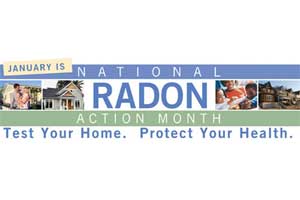
INFORMATION YOU SHOULD KNOW ABOUT RADON
from The New Jersey Department of Environmental Protection (DEP)
http://www.nj.gov/dep/rpp/radon/radoinfo.htm 
Radon is a naturally occurring radioactive gas, which has always been a part of our environment. It's a natural decay product of uranium and is found in soil everywhere in varying concentrations. The New Jersey Department of Environmental Protection (DEP) and the United States Environmental Protection Agency (EPA) have found that radon can also be an unwelcome part of our home environment.
Radon gas can accumulate in enclosed places, such as a house, but its presence, even in high concentrations, cannot be detected by human senses because the gas is invisible and has no odor. Long term or chronic exposure to radon has been linked to lung cancer. The greater the concentration and the longer a person is exposed, the greater the risk, so all people are encouraged to reduce their exposure. However, because of its physical characteristics, the only way to detect the presence of radon gas and measure the level is by a test. So people wanting to limit their exposure must first conduct a test to determine what their exposure levels are.
In New Jersey, there is a particularly uranium-rich geological formation, called the Reading Prong, which stretches from Pennsylvania through northwestern New Jersey into Southern New York State. Testing of homes built along this geologic formation has revealed high indoor levels of radon gas. Further testing in New Jersey, beyond the Reading Prong area, has shown additional areas where homes have elevated radon levels. This has led the DEP to conclude that radon is a statewide health issue. All homeowners are encouraged to test and, if levels are elevated, residents are urged to consider remediation.
Radon can move easily through soil and tiny cracks in rock. When it reaches the surface of the soil, it disperses and is diluted to very low levels in the outdoor environment. However, when the gas moves upward through soil beneath a home, it may enter through cracks or other openings in the foundation and build up to unacceptable levels.
Slight differences between indoor and outdoor pressure can affect the rate at which radon enters the home. Reduced indoor pressure draws the gas through any cracks and openings. This lower indoor pressure may be caused by open windows on the downwind side of the house, operation of kitchen or exhaust fans, and the use of air by furnaces and other large appliances. The fact that air in a house is often warmer than the surrounding air and tends to rise can also cause reduced indoor pressure. Another means of entrance for the gas is water supplies, particularly underground wells. However, the levels in water supplies in New Jersey are usually not high enough to present a significant risk by themselves. Also, public water supplies usually undergo a great amount of agitation and aeration during treatment, which releases the radon gas before it reaches any residence.
The higher the levels of radon gas in a home, the greater the amount inhaled. Just as radon is produced from the decay of radioactive materials, it further decays producing new radioactive materials in the form of solids. These radon decay products can attach to other particles, such as dust and cigarette smoke, which can be inhaled and become trapped in the lungs where they emit radiation. These decay products can damage lung tissue and increase the risk of developing lung cancer. The risk of lung cancer from a given exposure to radon is greater for a smoker than a non-smoker.
Lung cancer is the only known health effect linked to radon exposure at this time. The EPA estimates that between 15,000 and 22,000 of the 125,000 annual deaths from lung cancer may be attributable to radon exposure. In New Jersey, of the annual 4,700 lung cancer deaths, as many as 140-250 may be associated with radon exposure. These estimates of cancer risk from radon exposure are less than those caused by smoking, but are far greater than the number of cancers estimated to occur as a result of exposure to other environmental hazards, such as toxic chemicals in drinking water or pesticide residues on food.
For more information, please visit http://www.njradon.org  .
.
Copyright © State of New Jersey, 1996-2004
Department of Environmental Protection
P. O. Box 402
Trenton, NJ 08625-0402


